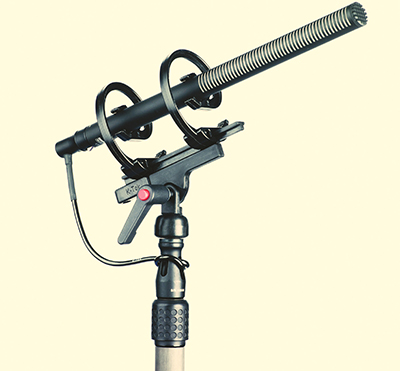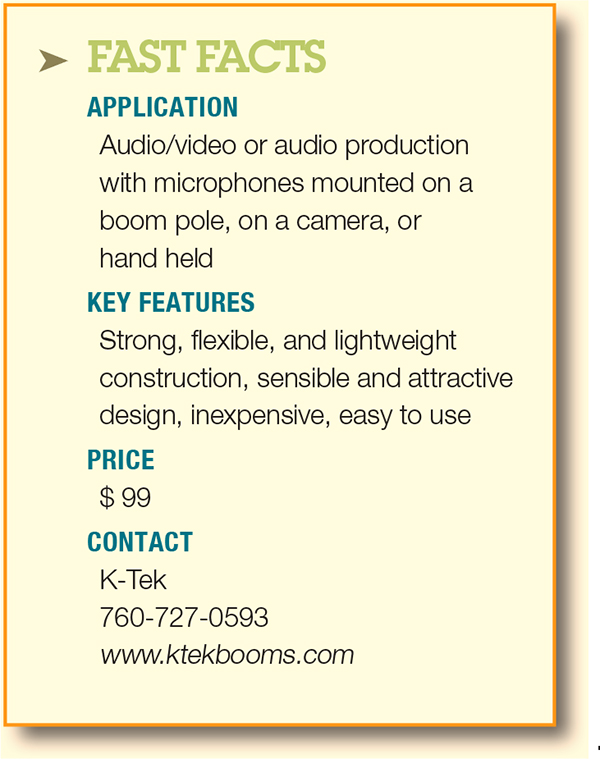K-Tek’s Nautilus Mic Suspension Mount
I’m a videographer who specializes in wildlife and always strive to record clean audio—mostly without a boom operator or a soundperson.
This means that I usually handle the mic-ing myself, mostly with the mic mounted on, or very near, the camera. Mounting the microphone off-camera is the best way to go, but is really only feasible when you’re shooting in a fairly stationary position. When I’m using the mic on-camera (which is most of the time), some kind of shockmount is needed to isolate vibration and handling noise.
Unfortunately, some shockmounts curtail the use of windscreens, or at least require their removal in order to mount the mic in the suspension. This can make switching mics in the field a cumbersome process, and something to avoid if at all possible. Moreover, some shockmounts are fairly flimsy and vulnerable to damage. Combining stability and suppleness with a rugged design is something of a challenge. K-Tek Boom Poles has met this challenge with their new Nautilus microphone suspension mount.
FEATURES

The K-Tek Nautilus microphone suspension system The Nautilus incorporates a revolutionary design from nature—the mathematically symmetrical spiral design of the chambered nautilus, a conch-like shellfish that’s widely admired for its symmetric spiral form. The Nautilus spiral was chosen over a host of other natural and artificial designs after a year of intensive R&D by the K-Tek design team. It evenly disperses force applied to the mount through a single continuous circular surface rather than concentrating it in multiple places. Moreover, the spiral design disperses the force evenly in three dimensions. The Nautilus suspends microphones from a center clamp of two or more spiral coils mounted on a rail. Depending on the length of the microphone, the rail can accommodate multiple coils, but typically only two are needed.
The coils can slide back and forth on the rail to adapt to the weight and dimensions of the mic being suspended, as well as to adjust the degree of stability desired vs. flexibility needed. Multiple rings can be bunched together or dispersed along the four-inch rail for optimum support. The mic is suspended in the center of the rings, which allows it to move in any direction, no matter what microphone orientation is desired. The flexible coil dissipates vibrations from the base of the mount, when handheld, or attached to a camera, a stand or other mount.
The Nautilus coils are constructed with a “new age” poly material that’s both flexible and strong. The mount’s spiral resembles a small letter “e,” without the horizontal line bisecting its center. A pair of rubberized pincers is used to grasp the shaft of the microphone. These pincers don’t lock, but rather flex enough to enable the microphone shaft to push past their nearly touching tips into the open center, forming a cradle for the shaft of most of the standard shotgun-type microphones.
The professional video industry's #1 source for news, trends and product and tech information. Sign up below.
K-Tek plans to offer different sizes of coils and clamps, to accommodate most popular mic sizes.
IN USE
At first glance, as much as I liked the Nautilus’s appearance, I couldn’t help but wonder if its thin structure could handle a hefty shotgun mic such as the Røde NTG without stretching or even breaking the clamp during insertion. This initial skepticism was quickly dispelled when I realized that the Nautilus was not made of your ordinary “cheap plastic.”
The device perfectly fit a standard-sized shotgun mic (Sennheiser’s new ENG style MKE 600, which is 10-inches long with a 3/4-inch shaft). My MKE 600 backed easily into mounting position on the twin coils and then pushed into both clamps after a only slight bit of initial resistance. Once seated, the MKE 600 couldn’t be dislodged from the Nautilus, even by vigorous shaking.
Some time ago I managed to lose the capsule from another shotgun mic in a different shockmount system that was not firmly attached and which was clamped in only one spot—not the two-clamp arrangement that the Nautilus uses. Ever since, I’ve been paranoid about a repeat incident and have become a stickler for mic stability and security. This led to the MKE 600 being given a thorough shakedown before I took it out for a trial run. (It passed with flying colors.)
During the time that I had the Nautilus for evaluation, I subjected it to daily jarring vibration on several miles of gravel “washboard” roads in the Black Mountains of Arizona. Even though the mic visibly flexed, it remained attached, enabling me to record some of my best ambient desert audio ever. I was able to capture wind gusts blended with the singing of mockingbirds, thrashers, desert doves and sparrows and even the braying of burros. The gusts were occasionally strong enough to force me to tighten my grip on the camera, yet none of this handling noise found its way onto the soundtrack, thanks to the Nautilus’s ability to isolate the mic from the camera body, despite being mounted to it.
Another feature I really enjoyed was being able to quickly and easily switch between the MKE 600 and other shotgun mics whenever I needed to.
One of these was the hefty Røde NTG. It took a bit of hard pushing to get the Røde to slide into the clamps. While it was finally gripped fairly firmly by the “fingers,” it was not as firmly clasped as the MKE 600 was. The mic’s back end wriggled free with moderate shaking. However, the front end held firm and pulled the back end back into the cradle after any vibration. The audio recorded was just as clean as with the MKE 600, but I wouldn’t choose to use the Røde with the Nautilus when hiking or driving a rough mountain road. Also, once I used it with the Nautilus for a few days, the clamps on the Nautilus wouldn’t grasp the slightly leaner MKE 600 as firmly as they had earlier. The smaller mic was cradled, but not that securely.
However, adding a third “unstretched” clamp at the end produced more stability. The lesson learned here was that while very good, the Nautilus clamps aren’t quite as resilient as I’d originally hoped and one size will not really fit all mics. I’ve since learned that K-Tek plans to produce clamps tailored to a microphone’s specific shaft dimensions, which should resolve this issue. However, adding a third or even fourth clamp is a sure way to bolster stability and provide optimal performance by Nautilus, even though it performed really well with only ywo clamps throughout my testing.

SUMMARY
K-Tek’s Nautilus microphone suspension system takes a fresh approach at isolating field vibration and mic handling noises by employing a spiral coil to spread out forces evenly over one long, circular surface, thus creating an even force distribution in three dimensions. This greatly attenuates handling noise and makes it easier to balance mics on a boom pole, camera or other mount, due in large part to a flexible, modular, rail-based mounting system.
Thanks to meticulous system design and testing—including the development of new strong, resilient, and lightweight base materials—the Nautilus takes microphone suspension to a new level, yet is fast and easy to use. While there may be some minor kinks yet to work out, the system is superior to most of the competing units, especially those that are priced anywhere close to the Nautilus. It’s well worth adding to one’s ENG/EFP/event shooting kit to assist in the coverage of everything from weddings to drama and interviews—even extreme weather coverage. The Nautilus has the potential to become a breakthrough audio support product with a broad spectrum of applications.
Carl Mrozek operates Eagle Eye Media, and specializes in wildlife and outdoor subjects. His work regularly appears on the Discovery Channel, The Weather Channel, CBS, PBS and other networks. Contact him ateagleye11@gmail.com.
